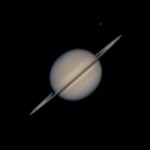I get email. Unlike some more controversial folks on the web, this does not normally contain hate mail. My messages are usually fun to read. A regular feature of my mail are astronomy newcomers asking the usual questions…
Hi,
I found your site while hunting around Google for an answer to a question. I wonder if you can help.
My telescope was bought during the winter of 2011. I’m new to hunting and finding stars and planets. This morning like many mornings I was out and about around 5:38 am. I live in the northern hemisphere, on a farm. As always I look around for any stars that might still be out before the Sun rises fully. If I look hard enough I can find a few. One always sticks out. It is to the south, high in the sky and very bright. At first I thought it was Saturn, but my star chart tells me Saturn would be closer to SSW at 5:35 in the morning. Being I’m not using a compass, I wonder if indeed I’m not facing true south. I’ve read it could be Sirius, but I don’t believe it is, maybe I’m wrong.
Are you able to give me some idea’s as to what star I’m looking at?
Thanks, and I hope you don’t mind the crazy question.
One more question. In the spring when I was looking at Saturn I could have sworn I was able to see the rings of Saturn tilting, or better stated moving up and down for lack of better wording. Am I correct in that? I am using a Celestron AstroMaster 114. Not the best but it was affordable, just in case star gazing was not for me.
Cheers,
[Name withheld]

[Name withheld],
Looking up whenever you walk outside is a good sign that you are indeed a stargazer at heart. I find myself doing the same any time I am under the night sky, even when walking across a supermarket parking lot I look up to see what stars or planets are visible.
Learning the sky simply takes a curious mind and a little experience. The patterns of the sky are regular and predictable. Keep learning and you will be able to recognize any bright star any time you step outside.
A remarkable early morning star could indeed be Sirius this time of year. This is the brightest visual star in the sky and can be quite striking. A quick look at the brightest star in the constellation Canis Major will also reveal the bright constellation Orion just to the north.
Each morning a fixed star like Sirius will rise about four minutes earlier, about one degree higher in the sky each day. The cycle repeats each year with the same stars visible in the same positions in the same season. By fall Canis Major and Orion will be in the evening sky and they will disappear into the Sun’s glare come spring.
Your description of Saturn is interesting… The angle of Saturn’s rings does change, but only over the months and years as the the Earth and Saturn orbit the Sun and the angle from which we view the planet changes.
It may not have been your imagination either. You may have been experiencing what astronomers call poor seeing. This is due to the air above, through which we view the heavens, distorting the light. the effect is the same thing that gives stars a twinkle or can cause the image to shimmer over a hot road. Normally the effect will blur the image slightly, coming and going with moments of clarity. When really bad the image of a star or planet can move about in the eyepiece. I have seen Jupiter look like a bouncing rubber ball under bad seeing conditions.
Keep looking up!
Andrew

